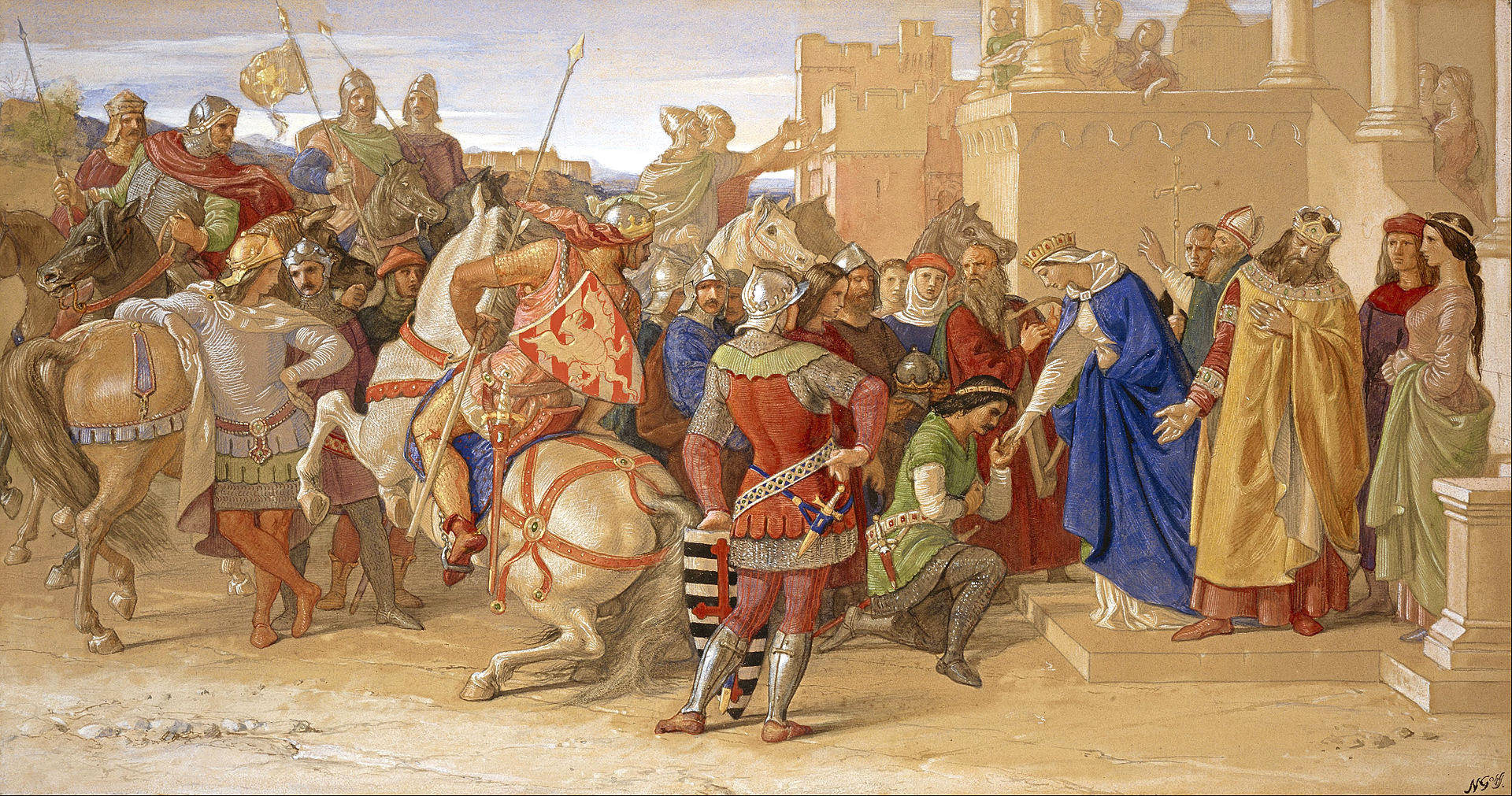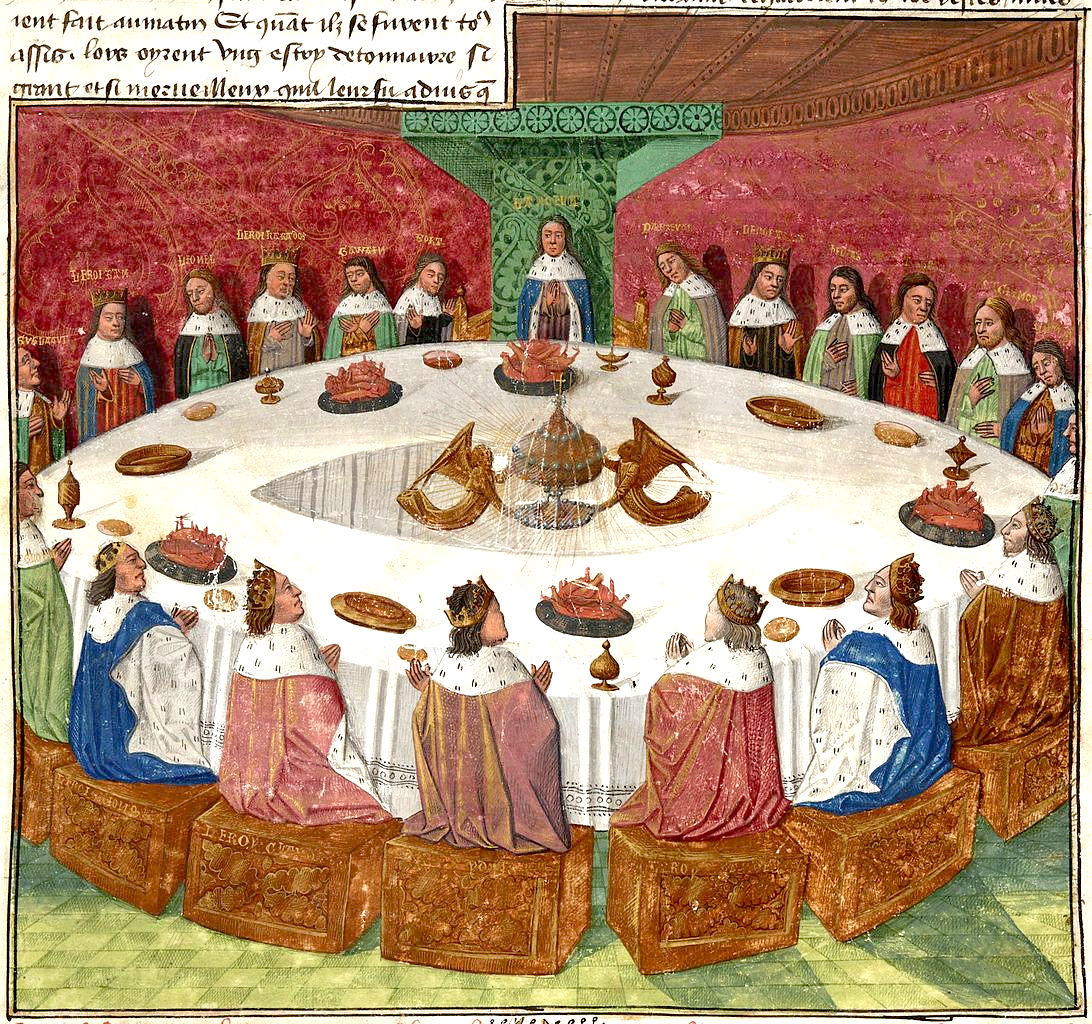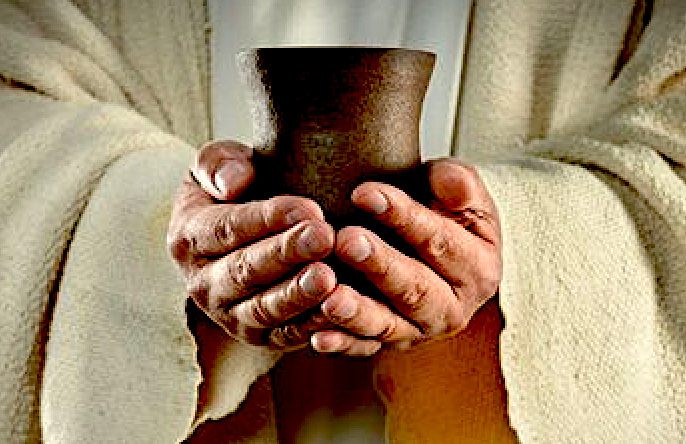
Knights
of the Round Table, depart in their quest to find the Holy Grail
In
the legend of King
Arthur Pendragon, he is famous for his quest to
find the Holy
Grail, Cup of Jesus
Christ, is a search for the divine in all of us.
The Holy Grail has become a central theme in Arthurian literature. Some historians have traced its association with Arthur as far back as some of the earliest legends about him. But the Grail first began to shine as a major Christian symbol in the twelfth and thirteenth centuries.
PENTECOST AT CAMELOT
It was the custom of King Arthur to celebrate the feast of Pentecost with all his knights around the Round Table. Each of the knights had their own seat at the Round Table with their name inscribed upon it, and there was one vacant seat known as the Siege Perilous. As the feast was about to begin a squire brought news that in a nearby river there was a red slab of marble that floated on the water. King Arthur led his knights to the river to investigate. Fixed firmly within this slab, as if it had been driven in, was a sword upon which was inscribed the following words,
“Never shall I be drawn forth except by he who is the perfect knight and at his side, I will hang.”
Sir Gawain tried to draw the sword but failed, as did Sir Percival and many others, but none could free it.
THE QUEST OF THE SANGREAL
Having investigated, they returned to the Round Table to eat. While they were eating the windows and doors all suddenly slammed shut. The candles flickered, went out and then came back on again, and stood before them appeared a very old holy man accompanied by Galahad, the son of Sir Lancelot. The holy man led Galahad to the Siege Perilous and seated him there. They watched in awe as the lettering on the seat changed magically to read, Galahad. King Arthur led Sir Galahad to the floating slab of marble and he easily withdrew the sword to the wonder of all.
Arthur and his knights returned to their feasting and again, the candles suddenly dimmed and there was a peal of thunder. A ray of light shone down and in the middle of the Round Table there appeared the glowing Sangreal veiled in white silk. Inspired by this miraculous event, Sir Gawain declared he would not rest, day or night, for one year and a day, until he saw the Sangreal fully unveiled. Arthur remembered the message of Merlin and was full of disquiet. He knew the others would follow his example and realized there was every chance some would die on that quest, or not return. In the early days of summer, as one hundred and fifty knights rode from Camelot on the quest of the Sangreal, King Arthur wept, knowing the world had changed forever.
THE SANGREAL TODAY
The Quest of the Sangreal has been expressed in many ways over the centuries including the works of art seen here and in many works of poetry, literature, and in films, television and other modern forms of entertainment. Modern films include;
Monty Python and the Holy Grail (1975), Excalibur (1985), Monty Python’s Spamalot (2004) a musical comedy for the stage,
Indiana Jones and the Last Crusade (1989) and The Fisher King (1991). Dan Brown used the theme in his novel,
The Da Vinci Code (2003), and it has been examined in many non-fiction works.
The quest was not really to find a material object but to complete a series of tests and lessons to achieve a state of spiritual perfection, and perhaps that is why its popularity remains as undiminished now as it was in earlier times.

THE HOLY CHALICE
The Holy Chalice, also known as the Holy Grail, is in Christian tradition the vessel that Jesus used at the Last Supper to serve wine. The Synoptic Gospels refer to Jesus sharing a cup of wine with the Apostles, saying it was the covenant in his blood. The use of wine and chalice in the Eucharist in Christian churches is based on the Last Supper story. In the late 12th century, the author Robert de Boron associated the pre-existing story of the Holy Grail, a magical item from Arthurian literature, with the Holy Chalice. This association was continued in many subsequent Arthurian works, including the Lancelot-Grail (Vulgate) cycle, the Post-Vulgate Cycle, and Sir Thomas Malory's Le Morte d'Arthur. A cup kept in the Spanish Cathedral of Valencia has been identified since Medieval times as the purported Holy Chalice used at the Last Supper.
THE LAST SUPPER
The Gospel of Matthew (26:27-29) says:
And He took a cup and when He had given thanks He gave it to them saying "Drink this, all of you; for this is My blood of the covenant, which is poured out for many for the forgiveness of sins. I tell you, I shall not drink again of the fruit of the vine until I drink it new with you in My Father's kingdom."
This incident, traditionally known as the Last Supper, is also described
by the gospel writers, Mark and Luke, and by the Apostle Paul in I
Corinthians. With the preceding description of the breaking of bread, it
is the foundation for the Eucharist or Holy Communion, celebrated
regularly in many Christian churches. The Bible makes no mention of the
cup except within the context of the Last Supper and gives no
significance whatsoever to the object itself.
KNIGHTS OF THE ROUND TABLE
The Knights of the Round Table, are the knights of the fellowship of King Arthur in the literary cycle of the Matter of Britain. First appearing in literature in the mid-12th century, the Knights are an order dedicated to ensuring the peace of Arthur's kingdom following an early warring period, entrusted in later years to undergo a mystical quest for the Holy Grail. The Round Table at which they meet is a symbol of the equality of its members, who range from sovereign royals to minor nobles.
The various stories in the cycle present an assortment of knights from all over Great Britain and abroad, some of whom are even from outside of Europe. Their ranks often include Arthur's close and distant relatives, such as Agravain and Gaheris, as well as his reconciled enemies and those he defeated in battle, including Galehaut and Lot. Several of the most notable knights, including Bedivere, Gawain, Kay and Yvain, are based on older characters associated with Arthur in the Welsh version of the myth. Many knights appear recurrently, such as Gawain, Lancelot, Percival and Tristan, with each of them featuring as a protagonist or eponymous hero in various works of chivalric romance. Other well-known members include the holy knight Galahad, replacing Percival as the achiever of the Grail, and Arthur's traitorous son Mordred.
By the end of Arthurian prose cycles (including the seminal Le Morte d'Arthur), the knights split up into groups of warring factions following the revelation of Lancelot's adultery with King Arthur's wife,
Queen
Guinevere. In the same tradition, Guinevere is featured with her own personal order of young warriors and knights, known as the Queen's Knights. Some of these romances retell the story of the Knights of the Old Table, led by Arthur's father, Uther Pendragon, whilst other tales focus on the members of the 'Grail Table'; these were the followers of ancient Christian Joseph of Arimathea, with his Grail Table later serving as the inspiration for Uther and Arthur's subsequent Round Tables.
MOST
MENTIONED KNIGHTS OF THE ROUND TABLE A - Z
Sir Agravain
King Arthur
Sir Bedivere
Sir Bors de Ganis
Sir Dagonet
Sir Ector
Sir Gaheris
Sir Galahad
Sir Gareth
Sir Gawain
Sir Geraint
Sir Kay
Sir Lamorak
Sir
Lancelot
Sir
Mordred
Sir Percival
Sir Tristan
EXCALIBUR
Some believe that
'Excalibur' was the sword King Arthur pulled out of the stone to claim his right to the throne of Britain.
Excalibur means ‘cut-steel’ and it is attributed with magical properties. Supposedly, it was formed with the heat from dragon-fire.
The sword served the King well until the scabbard, the sword cover, which was supposedly magical in nature, went missing. After this, he was defeated in battle and fearing his death, Arthur gave Excalibur to his Knight, Sir Bedivere to keep.



